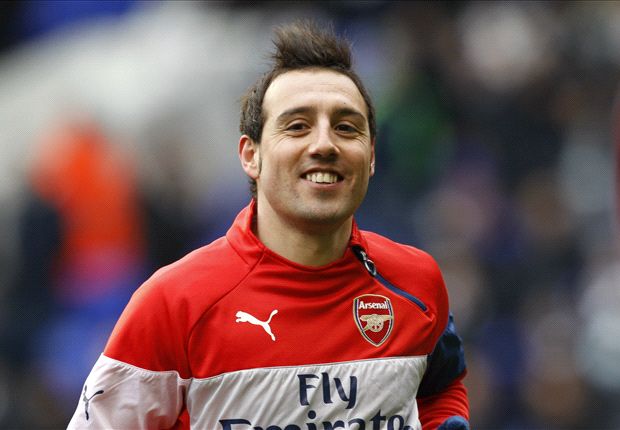
The Spaniard, often seen as the odd one out and threatened by big-money signings, has reinvented himself and now provides the platform for others in the Gunners squad to flourish
He could be Arsenal's hat-trick hero. Santi Cazorla goes to Wembley on Saturday as a common denominator in their only two trophy-winning successes in the last decade. He scored when they regained the FA Cup 12 months ago. He did again in August's Community Shield.
So did Aaron Ramsey, but the Spaniard can slip under the radar. Last year's showpiece may not be officially branded 'Ramsey's final', but it can feel that way: his was a tale of persistence rewarded, as his extra-time barrage of shots finally brought a goal, and of Arsene Wenger's faith justified, as one of his youthful protégés ended the Arsenal drought.
Yet Cazorla scored the free kick that began the fightback after Hull took a 2-0 lead. Cazorla scored the opening goal against Manchester City three months later. That is his role. He has become the man who provides the platform for others.
Ramsey's recovery, after his horrific leg-break at Stoke in 2010, captured the imagination, but Cazorla's is a very different story of a survivor. He could have been another Andrei Arshavin, a second Lukas Podolski, a third player who began well and then faded from the picture.
He wasn't a marquee signing. He isn't part of their generation of British talent. He looked the odd man out, the one who would be displaced by an expensive upgrade. Each summer has seemed to shift him down the pecking order. He was Arsenal's premier No.10 until Mesut Ozil arrived. He showed his adaptability by displaying his creative gifts on the left wing. Then Wenger bought Alexis Sanchez.
Now Cazorla has reinvented himself again. The small man with the big heart has been an unlikely success as a central midfielder, a flair player flourishing further from goal than many thought possible.
Arsenal went to Wembley nine months ago with a central midfield trio of Mikel Arteta, Jack Wilshere and Ramsey. Their improvement since then has come courtesy of an unlikely cast: David Ospina was the second-choice goalkeeper when the season started, Hector Bellerin the third in line for the right-back spot.
It is not merely their initials that make Francis Coquelin and Cazorla seem like the 'C' team. Theirs was an improbable alliance. It has proved an inspired piece of casting. Arsenal have won 17 of the 23 games when they have been paired.
They have lent the grit the Gunners were often accused of lacking, brought more protection to an often-exposed defence and illustrated the importance of balance. Coquelin at least was deemed a defensive midfielder; just not, in popular opinion, a particularly good one. Cazorla was sometimes bracketed as another of the band of fair-weather fantasistas.
He has confounded that theory. He was outstanding in January's 2-0 win at the Etihad Stadium. It was the defining result of Arsenal's resurgence, the day they illustrated they had tactical nous and determination, the time they finally seemed to have shed their inferiority complex.
Fresh from his loan spell at Charlton, Coquelin was the revelation. Cazorla was the commander at the base of the midfield. He has shown the creativity of a class act and the tenacity of a fighter. His willingness to accept responsibility – again, something many an Arsenal player has been accused of dodging – has been apparent in his penalty taking. His influence has been reflected whenever Per Mertesacker has not been on the field and Cazorla has donned the captain's armband.
The statistics, albeit amplified by those six spot-kicks, highlight the scale of his contribution. With seven league goals and 11 assists, he has been one of the most productive midfielders in England. Only Cesc Fabregas, a Spanish sorcerer in an earlier vintage of Arsenal teams, provided more goals for others. He completed 89 percent of his passes and none of the 15 Premier League players who showed greater accuracy fashioned more chances.
He has held off the young challengers of Ramsey and Wilshere, who both covet a central midfield role, and outperformed many a counterpart elsewhere. The shame is that he remains curiously underappreciated. There is a case for arguing Cazorla should have had the place on the shortlist for the PFA Player of the Year award that went Philippe Coutinho's way and not just because Arsenal's revival, unlike Liverpool's, was not built on sand.
Perhaps he was obscured by Alexis, the speedster who made the superlative start. Yet Cazorla is Arsenal's true renaissance man. He shows neither the precocity of a prodigy or Arsenal's new-found willingness to open the wallet, but he is the emblem of their progress. He has brought craft and graft, style and substance, attributes and attitude. They are qualities that enabled Arsenal to win the FA Cup last year and ones they will require if they are to beat Aston Villa on Saturday when Cazorla could complete a personal treble.



No comments:
Post a Comment